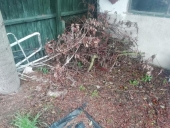The first mushroom that came to mind when I saw the pictures was
Boletus edulis - the shape is very close with that fat stem - but the colors are wrong for this species.
In general, it is best to consult guide books crafted for your specific geographic region, as some species will have deadly look-a-likes in other parts of the world. Immigrants who are experienced mushroom foragers will often poison themselves when moving to a different country because they mistake the local mushrooms for those growing in their home country.
If there are no printed guides available for South Africa, perhaps you can find somebody locally who is experienced in foraging mushrooms. Some areas have mycological societies where mushroom hunters can get together and share their collective wisdom.
The Wikipedia page on
Boletus http://en.wikipedia.org/wiki/Boletus notes that at least one person worldwide has been killed by eating a poisonous
Boletus mushroom, so exercise caution before eating any mushrooms that you find.
If you are determined to try some, first taste a small piece raw, chewing it up and spitting it out. If it tastes bad, don't eat it. If it tastes good, then you might consider cooking up a small piece, eating that, and waiting several days to see if there are any adverse reactions before consuming more.
Even if you are absolutely certain a mushroom is not poisonous, a cautious approach is best as many people can be allergic to mushrooms considered edible and delicious by others.






















































